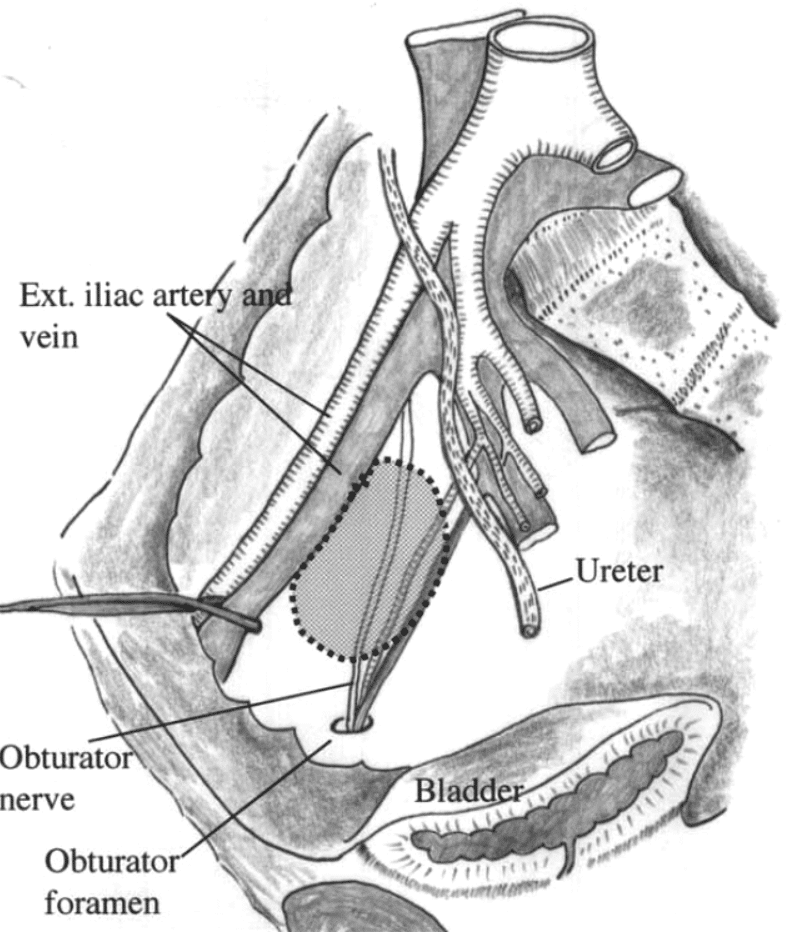Howship-Romberg sign
Howship-Romberg sign is a clinical indicator of obturator nerve compression, most frequently due to an obturator hernia, but can rarely result from other pelvic masses such as inflammatory granuloma.
Pain and paraesthesia along the distribution of the obturator nerve, classically radiating from the inner (medial) aspect of the thigh, down to the knee. Pain is exacerbated by thigh extension, abduction, and internal rotation of the hip, and relieved by thigh flexion.
Obturator hernia is rare, accounting for less than 1% of all abdominal hernias, and is most commonly seen in elderly, thin, multiparous women. The sign is present in 30–50% of cases and should raise suspicion in patients with symptoms of small-bowel obstruction without obvious cause.
Pathophysiologically, the sign arises from entrapment or irritation of the obturator nerve within the obturator canal by the hernia sac (or other lesion). The pain may mimic hip or knee arthritis, contributing to delayed diagnosis.

John Howship (1781-1841) was the first to describe the clinical syndrome (1840) whilst Moritz Heinrich Romberg (1795-1873) reported on the diagnostic criteria and explained the pathophysiology of an incarcerated obturator hernia in 1847.
History of Howship-Romberg sign
1840 – Howship first described the clinical phenomenon in an 1840 case report titled “Strangulated Thyroidal Hernia – Diagnostic Symptom – Appearances on Dissection”. He describes then case of an aged and emaciated female under the care of Mr. Weatherfield
…she was seized with violent spasmodic pain in the left side of the abdomen running down the left leg, with sickness, vomiting, and diarrhoea…The symptoms, those of strangulated hernia…She was bled, and directed various aperients and purgatives, a blister and leeches to the abdomen but towards the close of four days of severe suffering, sunk and died.
Howship 1840: 323
Postmortem examination revealed:
…a portion of small intestine was seen stretched towards the obturator foramen, where a knuckle was firmly impacted, forming a small hernia, no larger than a nutmeg, protruding through the opening. The intestine, highly inflamed, was almost gangrenous. The parts were carefully removed and admirably dissected; demonstrating the hernia to the best advantage
Howship 1840: 324
1847 – Moritz Heinrich Romberg (1795-1873) described his findings of an obturator hernia and their clinical significance (published in 1848)
Was diesem Falle ein besonderes Interesse verleiht, ist nicht seine Seltenheit, sondern die Aufklärung der Diagnose durch ein Nervenphänomen… Druck und Zerrung des Nervus obturatorius… manifest [durch] Schmerz an der inneren Seite des Oberschenkels… und Unfähigkeit, den Schenkel anzuziehen
Für die Hernia obturatoria ist ein diagnostisches Kriterium, wie es der Verein der Schmerzen und der gestörten Beweglichkeit des Oberschenkels mit der unterbrochenen Permeabilität des Darmcanals darbietet, um so bedeutungsvoller, weil dieser Bruch nur allmälig, gleichsam chronisch entsteht, selten eine von aussen sichtbare Geschwulst bildet, und, wie kein anderer Bruch, temporären, wiederholten Incarcerationen ausgesetzt ist.
What gives this case a special interest is not that it is rare, but the elucidation of the diagnosis by a neurologic phenomenon. Pressure and distortion of the obturator nerve… will manifest [through] pain on the inner side of the thigh… and inability to adduct the thigh
Obturator hernia is associated with pain; disturbed movement of the thigh; and altered intestinal movement. Most important, because this condition is chronic it rarely forms a tumour visible from the outside, and is subjected to temporary, repeated incarceration.
Late 19th–Early 20th century – The term “Howship–Romberg sign” appears in European surgical texts as a diagnostic feature of obturator hernia.
1951 – First successful surgical repair of an obturator hernia reported by Henry Obre, following Hilton’s earlier unsuccessful attempt.
1990 – Rizk & Deshmukh publish a review emphasizing the diagnostic importance of the sign in elderly women with small-bowel obstruction.
2004 – Yamashita et al. report a case of Howship–Romberg sign caused by an obturator granuloma from prior surgical suture material, highlighting that the sign is not pathognomonic for hernia.
Associated Persons
- John Howship (1781 – 1841)
- Moritz Heinrich Romberg (1795-1873)
References
Historical references
- Howship J. Strangulated Thyroideal Hernia-Diagnostic Symptom Appearances on Dissection. In: Practical Remarks on the Discrimination and Appearance of Surgical Disease. 1840: 323-4
- Romberg MH. Die Operation des eingeklemmten Bruches des eirunden Loches. Operatio hernia foraminis ovales incarceratae. In: Die operative Chirurgie. Dieffenbach JF 1848: 619-626
Epomymous term review
- Gumbs MA, Pandya GS, Kim YH. Obturator hernia. N Y State J Med. 1986 Mar;86(3):150-1.
- Bjork KJ, Mucha P Jr, Cahill DR. Obturator hernia. Surg Gynecol Obstet. 1988; 167(3): 217-22.
- Rizk TA, Deshmukh N. Obturator hernia: a difficult diagnosis. South Med J. 1990; 83(6): 709-12.
- Yamashita K, Hayashi J, Tsunoda T. Howship-Romberg sign caused by an obturator granuloma. Am J Surg. 2004; 187(6): 775-6.
- Mantoo SK, Mak K, Tan TJ. Obturator hernia: diagnosis and treatment in the modern era. Singapore Med J. 2009 Sep;50(9):866-70.
- Rastogi V et al. Abdominal Physical Signs and Medical Eponyms: Movements and Compression. Clin Med Res. 2018; 16(3-4): 76-82.
eponymictionary
the names behind the name
BA MA (Oxon) MBChB (Edin) FACEM FFSEM. Emergency physician, Sir Charles Gairdner Hospital. Passion for rugby; medical history; medical education; and asynchronous learning #FOAMed evangelist. Co-founder and CTO of Life in the Fast lane | On Call: Principles and Protocol 4e| Eponyms | Books |
